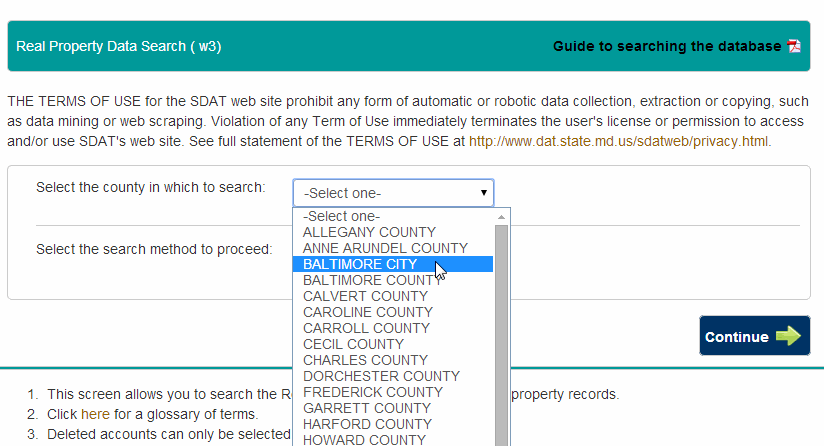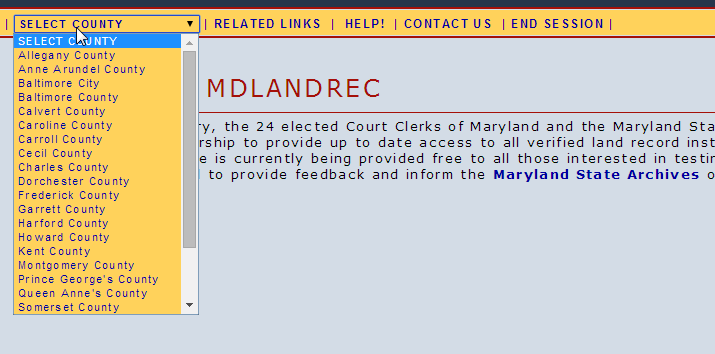1. Identify the address of the property
Find the address of the house or property you want to research. Google Maps or the Baltimore CityView mapping service are helpful in making sure you have the correct address for the property.
2. Use the Real Property Data Search to find the deed reference
Open the SDAT’s Real Property Data Search. Select “Baltimore City” from the drop-down list of counties and “Street Address” from the drop-down list of search methods then select continue.
Next, fill in the fields for street number and street name. You are required to enter a street name. Make sure to enter the street name only – not the prefix (e.g. North) or the suffix (e.g. Avenue). You are not required to enter a street number but searching with the street name only may return a large number of search results. Select next.

Review the information provided in the search result. If the search returns multiple properties, use the address or owner to select the correct property.
At the top of the page for the selected property, find the Account Identifier section and make a note of the block and lot numbers.
Below the Account Identifier is the Owner Information. Make a note of the owner name and the deed reference. In Baltimore City, the block number alone can be used to search for the deed but using the deed reference is often faster. The deed reference has at least two pieces a book number and a page number (sometimes known as a “liber” and “folio”). Many older deed references also include two or three letters that are the initials of the clerk who recorded the deed.
Below the Owner Information is the section on Transfer Information. Copy the names, transfer dates and deed references for any listed transfers. Only recent transactions are typically included so this section may be blank for buildings that have not recently been sold.
3. Use MDLandRec.net to find the current deed
Open the MDLandRec.net database in your browser and then log in to the MDLandRec website using your email and password.
Find the drop-down menu labeled Select County then select Baltimore City from the list of options. Find the search form under the heading Jump to new volume. The deed reference provided through the SDAT Real Property Database lists is a book number and a page number separated by a slash. These numbers are also known as the liber and folio. Fill in the book number and page number then select “Go!” Review the results of the search. Select the deed matching the most recent sale date of your property.

4. Examine the current deed for references to earlier deeds
Examine the deed to confirm that the information about the grantor, grantee and sale date matches what you know about the property. If it looks like you found the correct deed, search the document for a description of the property (often beginning, “Being the same lot…”). This typically provides information on the deed, grantor and sale date for the next deed in the chain.
5. Use MDLandRec.net to find earlier deeds in the chain
To find the next deed in the chain of title, select “Jump to a New Volume” or select “Search” to return to the original search form. Fill in the fields for book and volume with the deed reference you found in the description from the existing deed.
Examine the deed and look for another deed reference using the same phrase: “Being the same lot of ground…” The description should include the same information found in the previous deed: a grantor, a date of sale and a reference.
Repeat this same process again and again working your way back in time until the chain of title search is exhausted. Errors in notation and transcription and the combination of individual properties into larger transactions can make it difficult to locate the correct deed in some cases. Ideally, you can extend your chain of title search back before the date of construction of your house or property.
6. Interpret the chain of title to learn more
Who lived in the house or occupied the property?
The owners are not necessarily the residents or occupants of the property. Supplementing a chain of title search with research using census records, street directories and historic newspapers can confirm help document the history of occupancy.
How has the property changed over time?
The description of the property will typically include information about the boundaries of the property, their dimensions, and improvements. Garages, outhouses or other related structures may be identified and described in a deed. This is important to identify dates of construction for a house or any additions and outbuildings.
What does the chain of title reveal about the occupants, the property and the neighborhood?
Considering the frequency of the transactions, the sale price, and the respective identities of the buyer and seller can help reveal events in the lives of the occupants or broader patterns in the history of the neighborhood or the city. Perhaps the sale is prompted by a death in the family, a building fire, or a move to another city. Knowing the year a property is bought or sold can help to focus your research on relevant sources and information.
7. Review your Chain of Title
We followed the chain of Title for 11 ½ West Chase Street, Baltimore, MD 21201 back to 1919. Can you follow it back further?
| Grantor | Grantee | Deed Reference (Initials/Liber/Folio) | Transfer Date | Sale Price |
| Donnell M. Smith and Florence C. Smith and Thomas W. Smith and Elizabeth C. Smith | The Baltimore Chapter of the American Institute of Architects | SEB 1672 505 | May 31, 1988 | $100,000 |
| Henry A. Parr, III and Mary H. Parr | Donnell M. Smith and Florence C. Smith, Thomas W. Smith and Elizabeth C. Smith | JFC 1726 621 | July 17, 1964 | $5 |
| Edward Turner | Henry A. Parr, III and Mary H. Parr | 1697 80 | May 27, 1964 | … |
| DeWitt B. Casler and Carolyn B. Casler | Edward Turner and Mary Virginia Easter Turner | MLP 9087 100 | March 2, 1953 | … |
| Albert Gilmore | DeWitt B. Casler and Carolyn B. Casler | SCL 3326 269 | February 18, 1919 | … |
